Morphology and Chemical Composition of Magnetic Particles Separated from Coal Fly Ash
Abstract
:1. Introduction
2. Research Methodology
2.1. Sample Preparation
2.2. Particle Morphology and Elemental Composition
2.3. Particle Size Distribution
2.4. Mineralogical Composition
3. Results
3.1. Particle Size Distribution
3.2. Particle Morphology
3.3. Magnetic Particles’ Elemental Compositions
3.4. Magnetic Particles Mineralogy
4. Discussion
5. Conclusions
Supplementary Materials
Funding
Institutional Review Board Statement
Informed Consent Statement
Data Availability Statement
Acknowledgments
Conflicts of Interest
References
- Zyryanov, V.; Petrov, S.; Matvienko, A. Characterization of spinel and magnetospheres of coal fly ashes collected in power plants in the former USSR. Fuel 2011, 90, 486–492. [Google Scholar] [CrossRef]
- Blissett, R.; Rowson, N. A review of the multi-component utilisation of coal fly ash. Fuel 2012, 97, 1–23. [Google Scholar] [CrossRef]
- BP Statistical Review of World Energy. 2021. Available online: https://www.bp.com/en/global/corporate/energy-economics/statistical-review-of-world-energy.html (accessed on 23 December 2021).
- Balaguera, A.; Carvajal, G.I.; Albertí, J.; Fullana-i-Palmer, P. Life cycle assessment of road construction alternative materials: A literature review. Resour. Conserv. Recycl. 2018, 132, 37–48. [Google Scholar] [CrossRef]
- Zhao, Z.; Xiao, F.; Amirkhanian, S. Recent applications of waste solid materials in pavement engineering. Waste Manag. 2020, 108, 78–105. [Google Scholar] [CrossRef] [PubMed]
- Mondal, D.; Das, S.; Ramakrishnan, N.; Bhasker, K.U. Cenosphere filled aluminum syntactic foam made through stir-casting technique. Compos. Part A Appl. Sci. Manuf. 2009, 40, 279–288. [Google Scholar] [CrossRef]
- Matsunaga, T.; Kim, J.; Hardcastle, S.; Rohatgi, P. Crystallinity and selected properties of fly ash particles. Mater. Sci. Eng. A 2002, 325, 333–343. [Google Scholar] [CrossRef]
- Gupta, N.; Luong, D.D.; Cho, K. Magnesium matrix composite foams—Density, mechanical properties, and applications. Metals 2012, 2, 238–252. [Google Scholar] [CrossRef] [Green Version]
- Nakonieczny, D.S.; Antonowicz, M.; Paszenda, Z.K. Cenospheres and their application advantages in biomedical engineering—A systematic review. Rev. Adv. Mater. Sci. 2020, 59, 115–130. [Google Scholar] [CrossRef]
- Kasar, A.K.; Gupta, N.; Rohatgi, P.K.; Menezes, P.L. A brief review of fly ash as reinforcement for composites with improved mechanical and tribological properties. JOM 2020, 72, 2340–2351. [Google Scholar] [CrossRef]
- Zhao, Y.; Xi, B.; Li, Y.; Wang, M.; Zhu, Z.; Xia, X.; Zhang, L.-Y.; Wang, L.; Luan, Z. Removal of phosphate from wastewater by using open gradient superconducting magnetic separation as pretreatment for high gradient superconducting magnetic separation. Sep. Purif. Technol. 2012, 86, 255–261. [Google Scholar] [CrossRef]
- Yang, J.; Zhao, Y.; Zyryanov, V.; Zhang, J.; Zheng, C. Physical–chemical characteristics and elements enrichment of magnetospheres from coal fly ashes. Fuel 2014, 135, 15–26. [Google Scholar] [CrossRef]
- Sharonova, O.M.; Fedorchak, M.A.; Zhizhaev, A.M.; Mazurova, V.; Anshits, A.G. Composition of individual ferrrospheres of different morphological types. Inorg. Mater. 2015, 51, 1143–1150. [Google Scholar] [CrossRef]
- Zhao, Y.; Zhang, J.; Sun, J.; Bai, X.; Zheng, C. Mineralogy, chemical composition, and microstructure of ferrospheres in fly ashes from coal combustion. Energy Fuels 2006, 20, 1490–1497. [Google Scholar] [CrossRef]
- Yang, J.; Zhao, Y.; Zhang, S.; Liu, H.; Chang, L.; Ma, S.; Zhang, J.; Zheng, C. Mercury removal from flue gas by magnetospheres present in fly ash: Role of iron species and modification by HF. Fuel Process. Technol. 2017, 167, 263–270. [Google Scholar] [CrossRef]
- Kukier, U.; Ishak, C.F.; Sumner, M.E.; Miller, W.P. Composition and element solubility of magnetic and non-magnetic fly ash fractions. Environ. Pollut. 2003, 123, 255–266. [Google Scholar] [CrossRef]
- Fomenko, E.; Anshits, N.; Solovyov, L.; Mikhaylova, O.A.; Anshits, A. Composition and morphology of fly ash cenospheres produced from the combustion of Kuznetsk coal. Energy Fuels 2013, 27, 5440–5448. [Google Scholar] [CrossRef]
- Fomenko, E.V.; Anshits, N.N.; Solov’Ev, L.A.; Mikhailova, O.A.; Anshits, A.G. Composition and structure of the shells of fly ash cenospheres from the combustion of coal of the Kuznetsk Basin. Solid Fuel Chem. 2014, 48, 129–139. [Google Scholar] [CrossRef]
- Xing, Y.; Rosner, D.E. Prediction of spherule size in gas phase nanoparticle synthesis. J. Nanopart. Res. 1999, 1, 277–291. [Google Scholar] [CrossRef]
- Lu, S.; Chen, Y.; Shan, H.; Bai, S. Mineralogy and heavy metal leachability of magnetic fractions separated from some Chinese coal fly ashes. J. Hazard. Mater. 2009, 169, 246–255. [Google Scholar] [CrossRef] [PubMed]

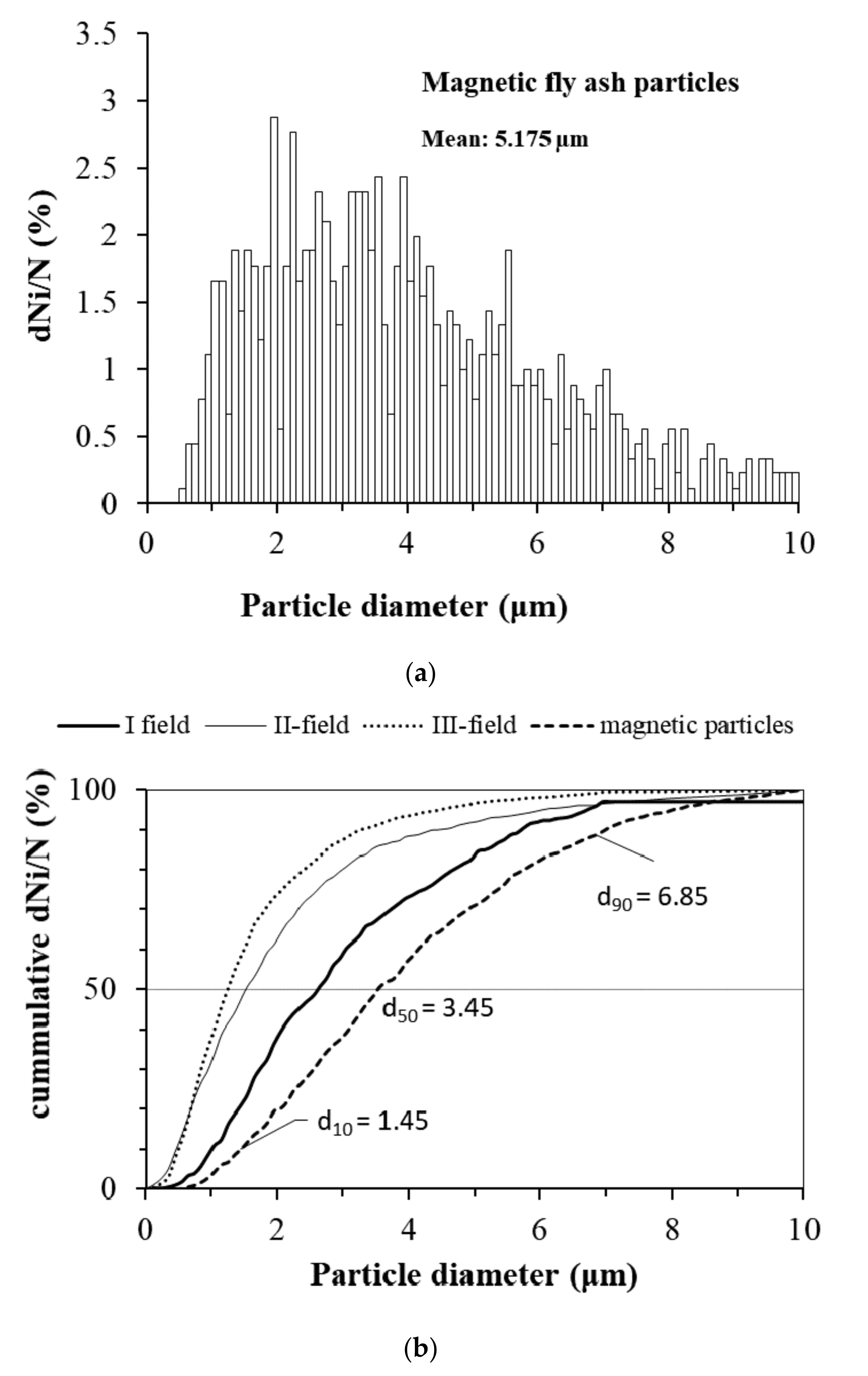
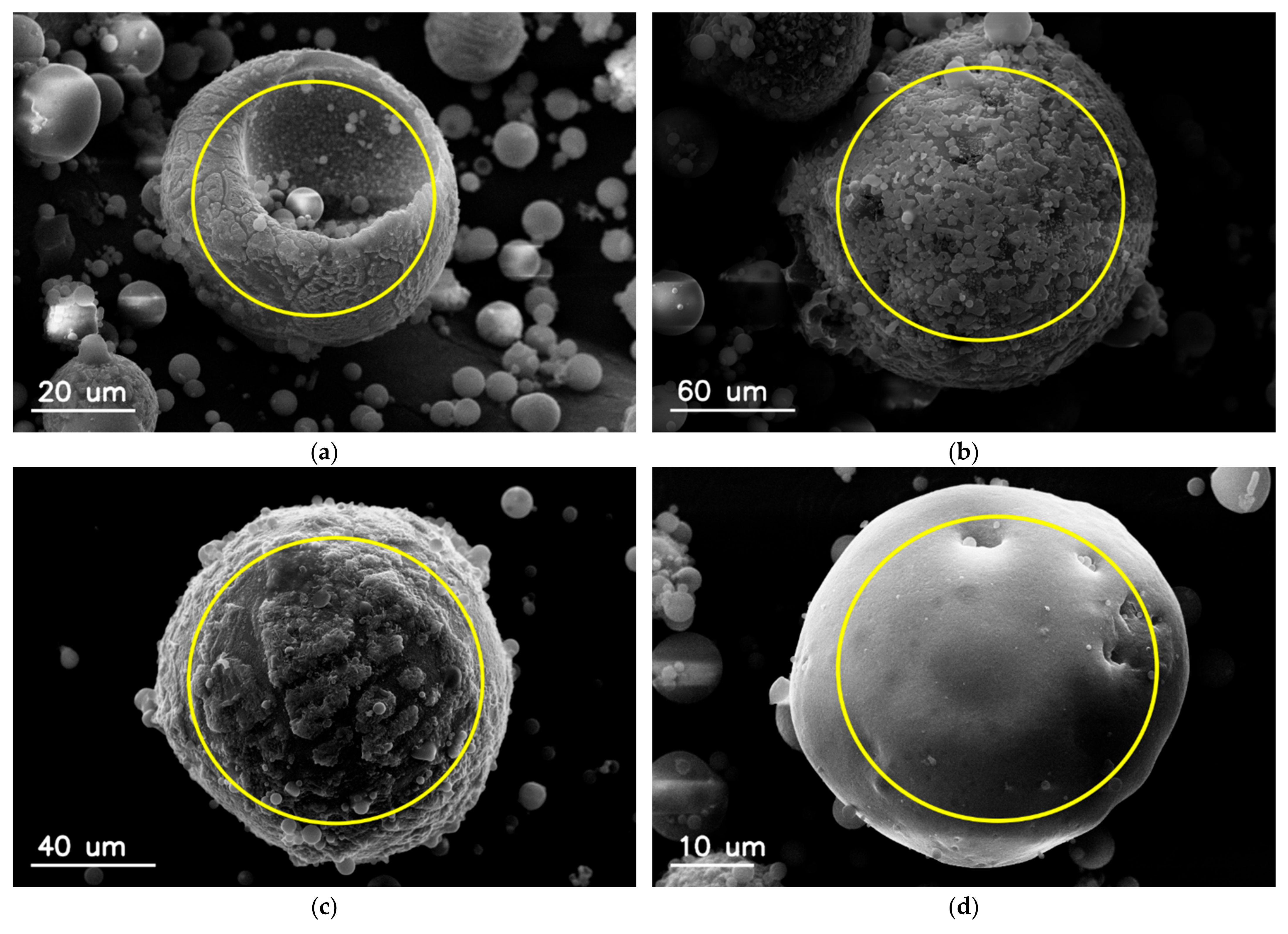
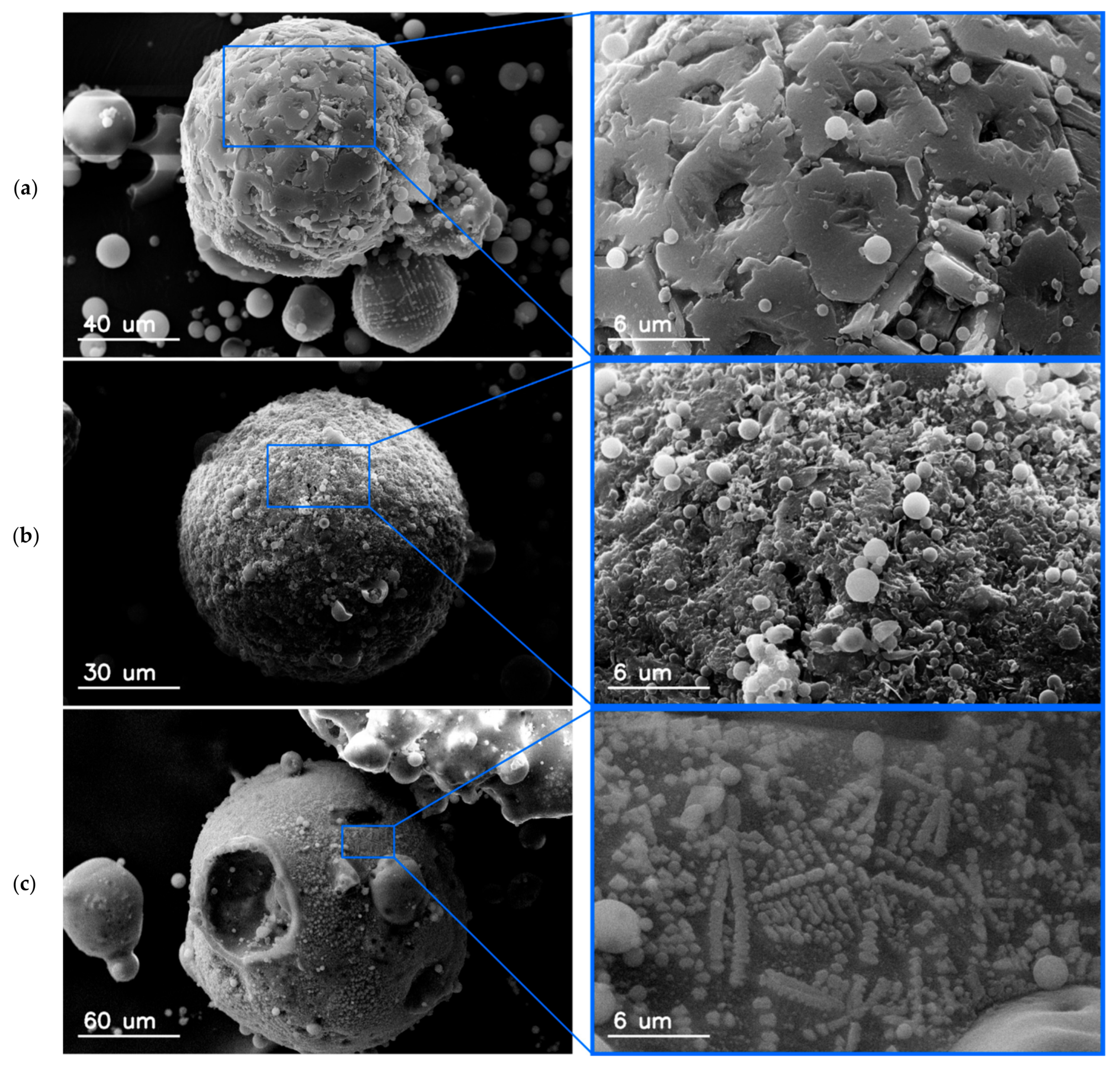
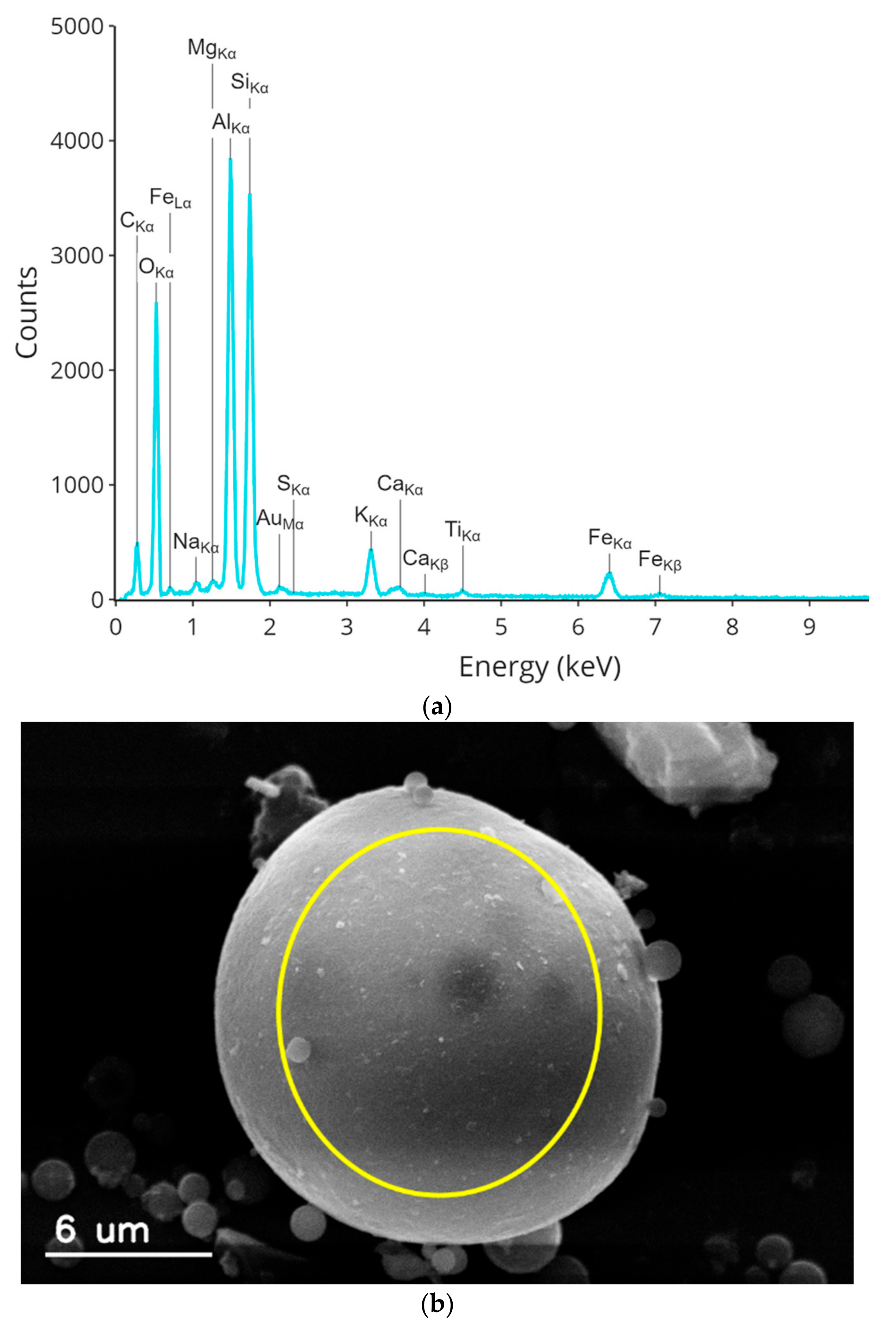
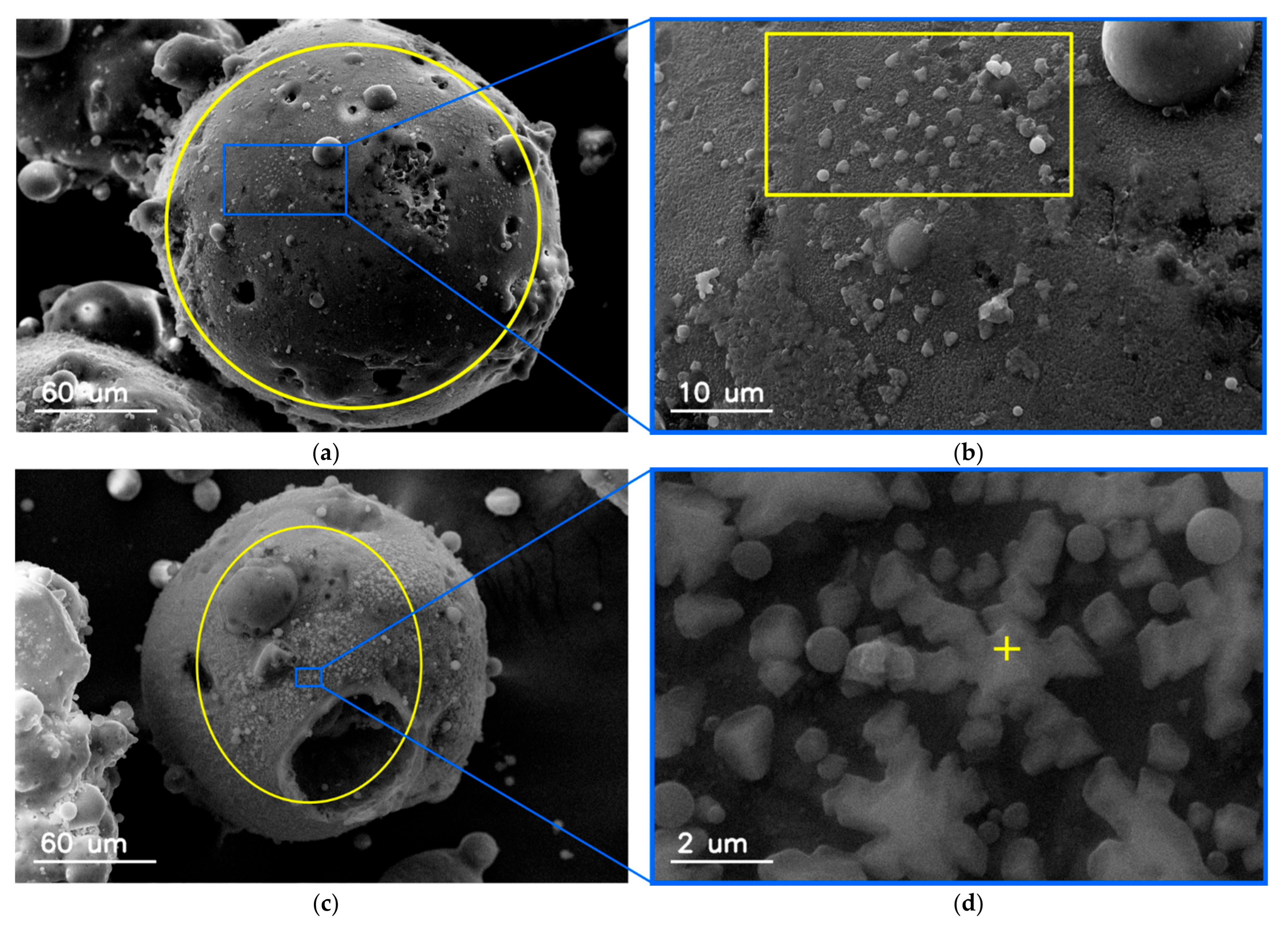
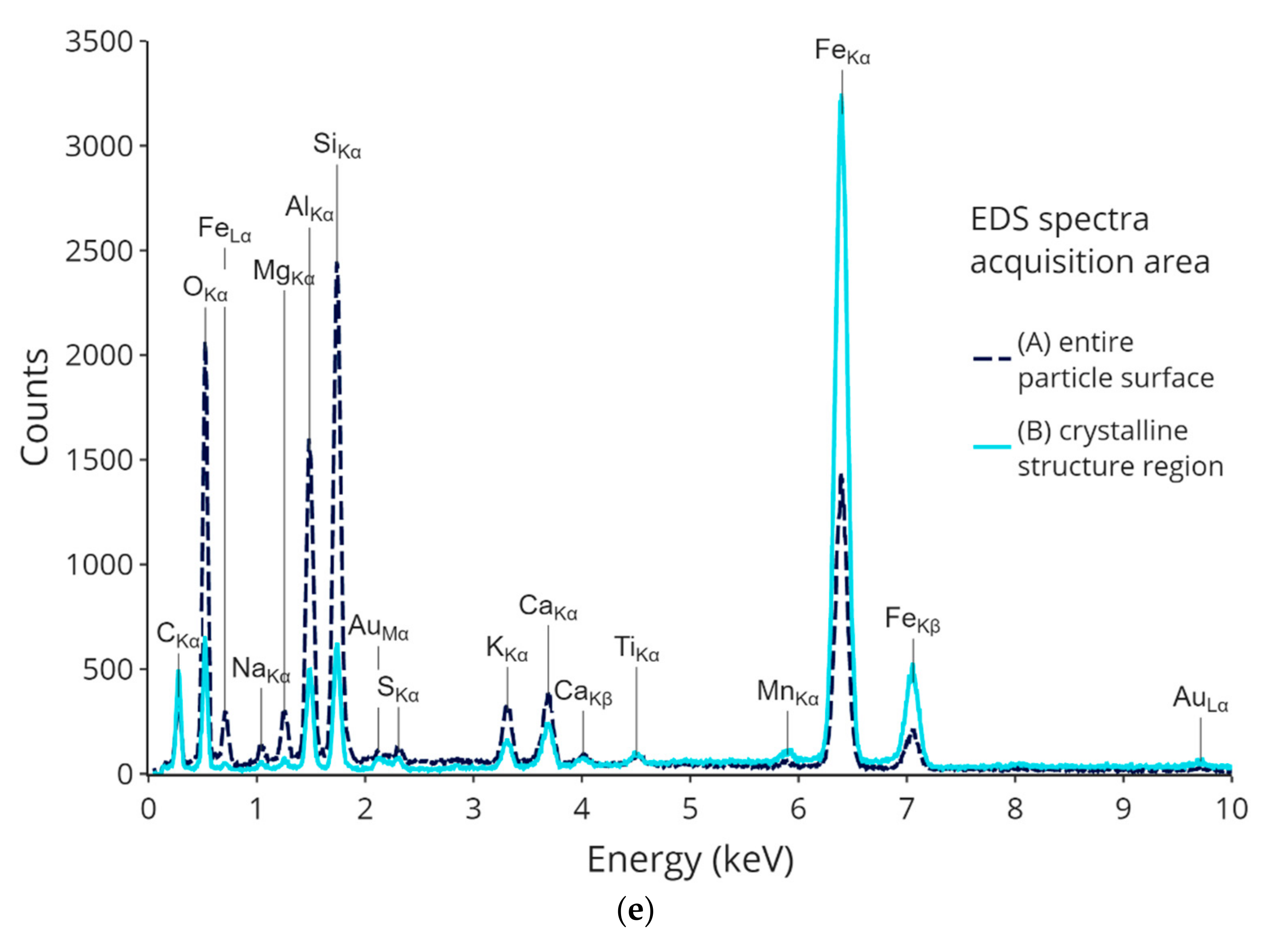

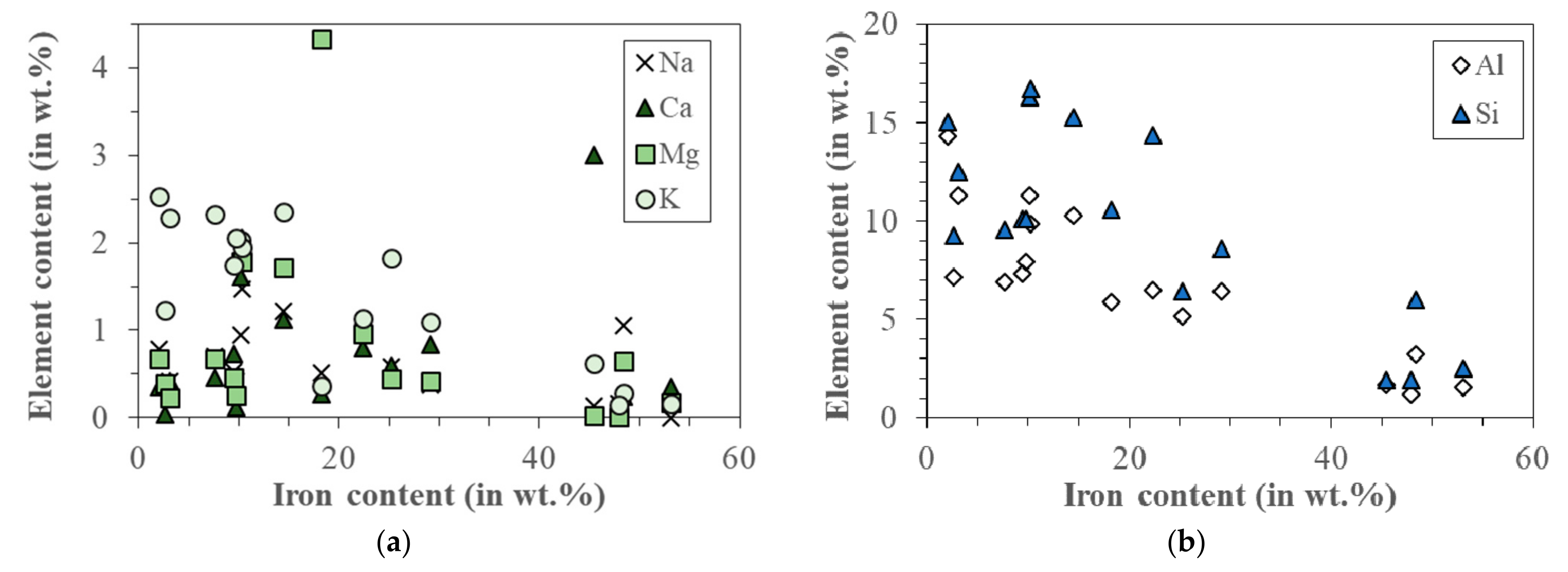

| Type of Magnetic Particles | Iron Content (wt.%) |
|---|---|
| ferrooxides | Fe ≥ 75% |
| Aluminosilicate-bearing ferrooxides | 75% ≥ Fe ≥ 50% |
| Ferriferous aluminosilicates | 50% ≥ Fe ≥ 25% |
| Ferro-aluminosilicates | 25% ≥ Fe |
| C | O | Na | P | Al. | Si | Cu | S | Fe | Mg | Mn | Ti | Ca | K |
|---|---|---|---|---|---|---|---|---|---|---|---|---|---|
| 19.35 | 49.84 | 0.41 | 0.00 | 11.29 | 12.48 | 0.13 | 0.03 | 3.06 | 0.23 | 0.01 | 0.37 | 0.41 | 2.28 |
| EDS Spectrum Area | C | O | Na | P | Al. | Si | Cu | S | Fe | Mg | Mn | Ti | Ca | K |
|---|---|---|---|---|---|---|---|---|---|---|---|---|---|---|
| A | 15.45 | 45.79 | 0.49 | 0.01 | 7.15 | 10.69 | 0.11 | 0.17 | 14.29 | 1.54 | 0.12 | 0.32 | 2.22 | 1.65 |
| B | 24.93 | 20.20 | 1.63 | 0.00 | 7.45 | 8.28 | 0.21 | 0.53 | 31.56 | 1.10 | 0.35 | 0.34 | 2.00 | 1.40 |
| C | 8.16 | 44.25 | 1.21 | 0.01 | 10.30 | 15.28 | 0.16 | 0.05 | 14.43 | 1.72 | 0.07 | 0.47 | 1.12 | 2.35 |
| D | 2.84 | 39.83 | 1.12 | 0.08 | 6.83 | 9.08 | 0.21 | 0.19 | 34.53 | 2.43 | 0.15 | 0.28 | 1.10 | 1.32 |
Publisher’s Note: MDPI stays neutral with regard to jurisdictional claims in published maps and institutional affiliations. |
© 2022 by the author. Licensee MDPI, Basel, Switzerland. This article is an open access article distributed under the terms and conditions of the Creative Commons Attribution (CC BY) license (https://creativecommons.org/licenses/by/4.0/).
Share and Cite
Czech, T. Morphology and Chemical Composition of Magnetic Particles Separated from Coal Fly Ash. Materials 2022, 15, 528. https://doi.org/10.3390/ma15020528
Czech T. Morphology and Chemical Composition of Magnetic Particles Separated from Coal Fly Ash. Materials. 2022; 15(2):528. https://doi.org/10.3390/ma15020528
Chicago/Turabian StyleCzech, Tadeusz. 2022. "Morphology and Chemical Composition of Magnetic Particles Separated from Coal Fly Ash" Materials 15, no. 2: 528. https://doi.org/10.3390/ma15020528





